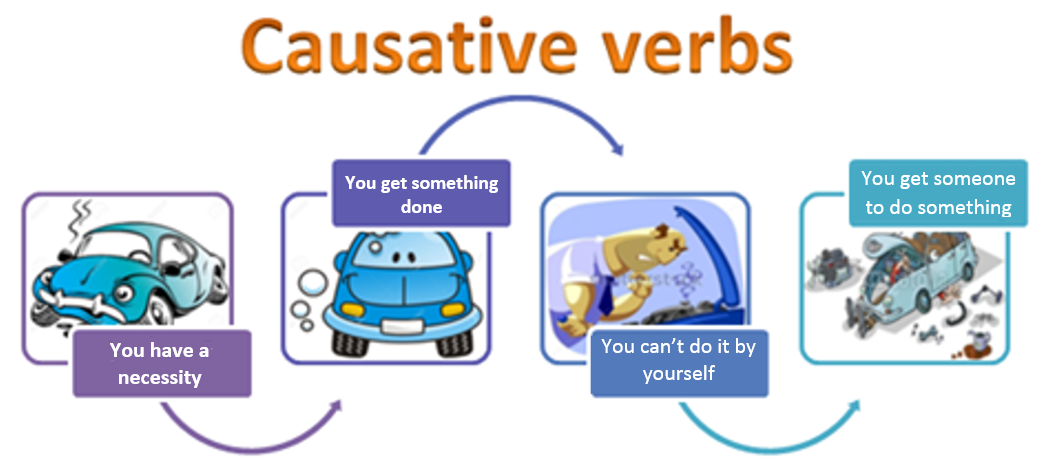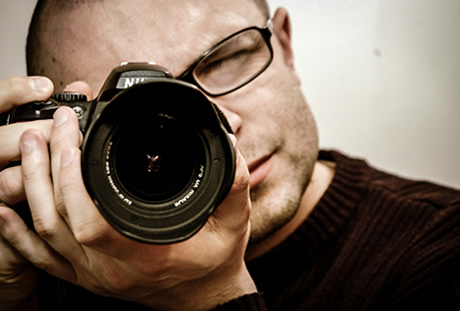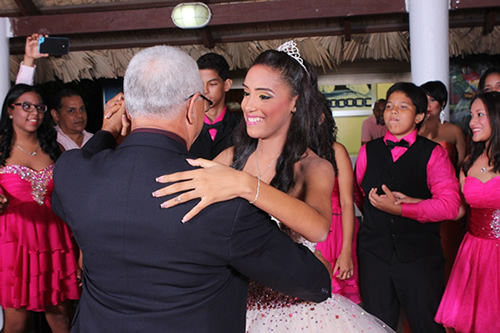Could you distinguish when a structure is used to express that you did some action and another in which you ordered someone else to do it? Don’t worry, in this section, you will learn how!
As mentioned previously, you will learn how to use causatives in passive voice to express actions that other people do or did for us.
Causative verbs are used to describe several actions where other persons participate.
The understanding of this topic is fundamental to distinguish who did the actions in the causatives sentences.

Causative structures are used to talk about what someone else did for us. In other words, causatives are used when the agent causes someone else to carry out an action for this agent.
They are characterized by:
a) a protagonist or agent causing the action to be done
b) the use of one of two verbs (have or get) conjugated in any tense or with a modal form
c) the presence of an object receiving the action
d) the inclusion of the action in participle form
e) a context or circumstance for the phrase (sometimes, not always)
Look at these examples:
• I usually have my hair cut once a month.
• The company got another branch office opened.
• He’s having the report checked tomorrow morning.
• Mr. Tanaka will get the archive signed immediately.
As you can see, this structure is useful in terms of practicality because it designates those situations in which a favor, a command or a service takes place.
Read the following cases and identify the causative structures.

Jarmoluk, M. (2014). Foto. Tomada de:
https://pixabay.com/es/fot%C3%B3grafo-c%C3%A1mara-foto-fotos-lente-428388/
If you have ever gotten a valid identification card, credential or certificate, then you must have had a picture taken. Your photo is in it, but you did not take the picture yourself. Somebody else did.

Medina, O. (2016). Fiesta. Tomada de:
https://pixabay.com/es/bailando-15-a%C3%B1os-fiesta-vestido-1147012/
If you have, then you probably have had your fingernails painted, if you are a girl. And you had to pay so that a beautician did that for you.

Frohnhoff, H. (2015). Tiempo. Tomada de:
https://pixabay.com/es/tiempo-calendario-de-cita-pluma-750324/
Then you probably have got your paper bound in metal spiral binding in a stationary shop. It is your paper, but you had to ask or cause someone with a spreading device that allows for comb binding or spiral metal binding to do that for you.
By the end of this topic, you will:
• Make use of verbs HAVE and GET in causative situations to describe actions requested or ordered by you and not done by yourself, but by someone else.
Causative structures or causative sentences are those in which the doer is not the subject of the sentence.
There are two types of causative structures: those with an agent and those without an agent. In this section, only causative sentences without an agent will be studied.
In causative structures, a causative verb is a verb used to indicate that some person or thing makes—or helps to make—something happen.
We will start getting familiar with the causative structure and its use. Write the number whose sentence best describes the picture.
The practice of the structure will enable you to use it whenever you request or order, or when you report these functions from other agents.
Complete the sentences using the verbs in the box.
Now that you have finished your sentences match them according to each of the following images:
Placing the components of the causative structure in the correct order is helpful to structure things done by others. Put in order in the following sentences.
Activity 1
Have you ever been to a hotel? What activities have you done by yourself? What actions have you asked the hotel staff to do for you?

Mark, D. (2013). Skyline. Retrieved from: https://pixabay.com/en/ship-hainan-china-skyline-105596/
Let’s practice with a simulated situation in which added value is regarded. This value has different manifestations..
Activity 2
Reading is essential when you learn a foreign language.
Three reasons can be mentioned:
a) You can take your time to assimilate the information.
b) You can learn many words.
c) it’s a chance to enhance your comprehension of the structure in turn.
Have you ever travelled to Greece? What services do you imagine you could have at the Paros Philoxenia, a four stars hotel?
In the following link, you will read about the Paros Philoxenia Hotel. Click “T” if the service can be gotten at the Paros Philoxenia Hotel or the letter “F” if not. For this purpose, identify the structure of the brochure and look for specific information.
Activity 3
Apart from the ones reviewed in the reading stage, what other services can or cannot be gotten at a hotel?
This activity will help you to monitor your learning of the causative structure. Write five passive causative sentences, either an affirmative or negative form, giving real information about services that are offered or not at a definite hotel in the real world.
Follow the example:

Holande. (2016). Dubai. Tomada de: https://pixabay.com/en/hotel-dubai-burj-al-arab-emirates-1673952/
Self-assess through the rubric and verify that your sentences have the semantic parts of the sentences presented in the passive causative structures introduced at the beginning.
AFFIRMATIVE
| Agent | Have/Get | Object | Participle |
| Somebody | caused causes is going to cause |
Something | to have happened to happen |
NEGATIVE
| Agent | Negation of causative | Object | Participle |
| Somebody | Not causing Not forcing Not allowing |
Something | to happen |
INTERROGATIVE
| Wh Word | Auxiliary | Agent | Have / Get | Object | Participle |
| Optional | Has | She | Had/Got | her homework | checked yet? |
You could also check in the reference section more information about causatives.
Then evaluate yourself using the following checklist:
Activity 4
Have you ever undergone the stress of getting prepared for a formal party?

Rita. (2016). Strawberry. Tomada de: https://pixabay.com/en/strawberry-roll-strawberry-1263099/
This exercise will let you identify the causative structure with sounds and rhythm. Underline the correct answers based on the sketches.
Activity 5
Have you ever needed to get a service carried out for you?
Record yourself or have a video taken acting out the following five sentences or five sentences of your own. Each sentence should last between 5 to 10 seconds.
Remember to check the following elements:
After finishing your audio, record it and evaluate it using the following checklist by selecting one scale per parameter. In the end, check your score and reflect on how good you are at using the causative.
Example:
In this final activity, you will demonstrate yourself how much you master the topic studied.
Change the active simple sentences into passive causative structures. Follow the example:
Active Simple |
Passive Causative |
|
|
ANSWER KEY FOR SELF-ASSESSMENT:
For self-assessment, compare your answers with the models provided. Remember those open registration items are miscellaneous.
EPILOGUE:
The team of designers candidly hopes so!
See you around.
(2016). English Grammar: causative get and have. Video: https://www.youtube.com/watch?v=u53xdjlHn0g
Senoid. (2016). Perfect English Grammar. http://www.perfect-english-grammar.com/causatives-have-get.html